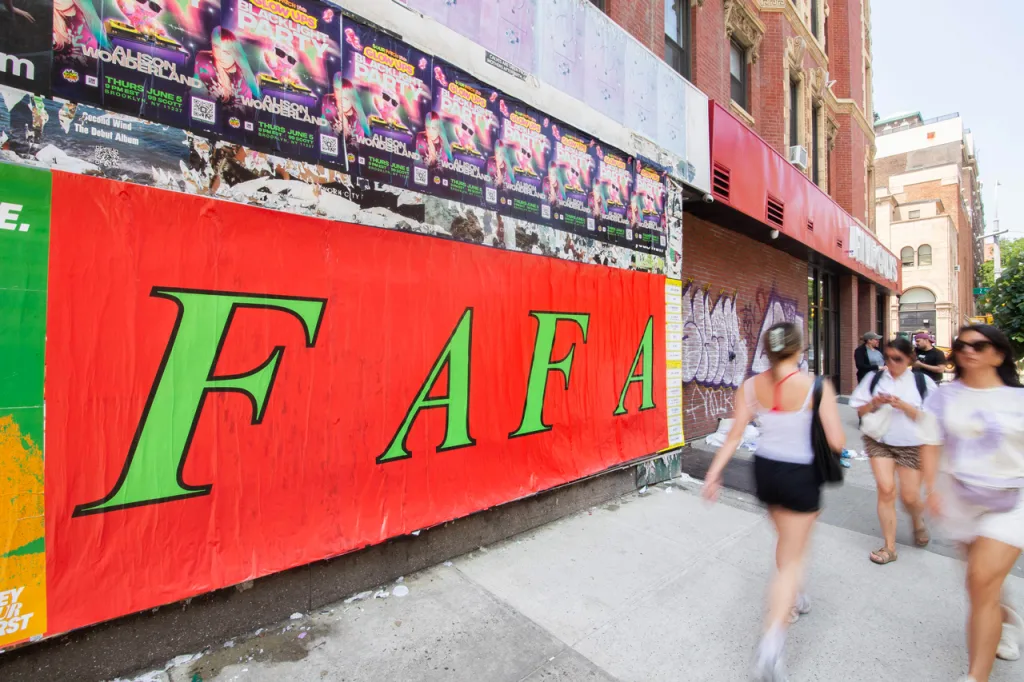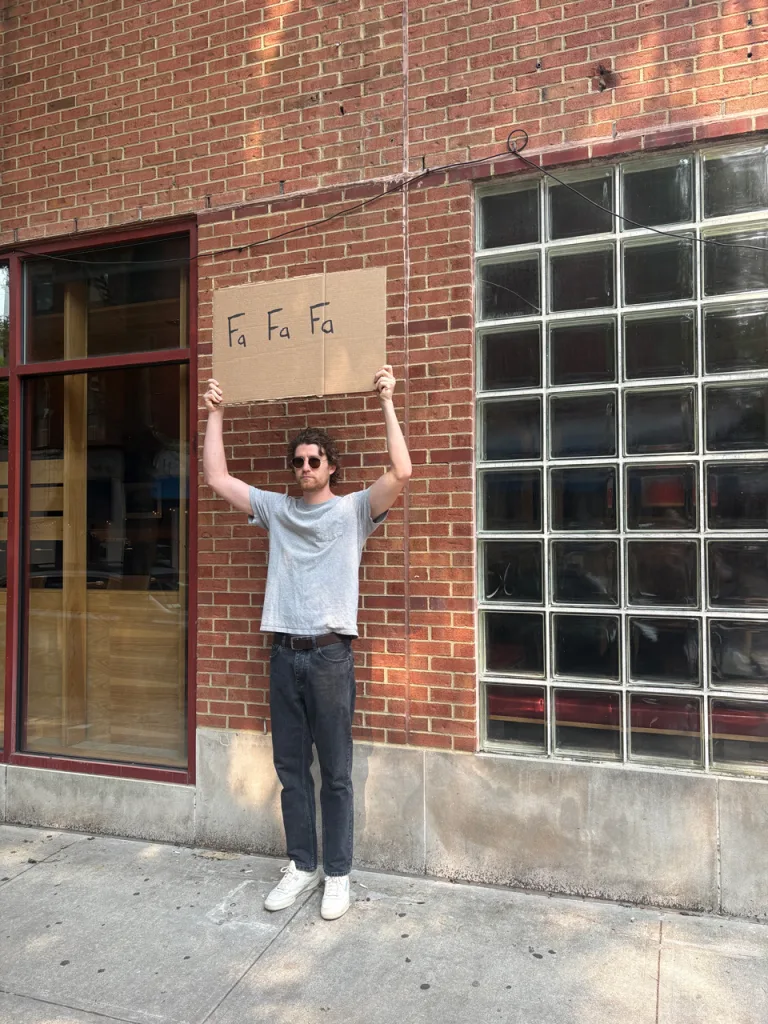How Talking Heads fa-fa-fa-fa’d all over NYC to celebrate the band’s 50th anniversary
Legend has it that Talking Heads played their first-ever show on June 5, 1975, in New York City, opening for the Ramones at CBGB on the Bowery. Now, 50 years later, stickers, wheatpaste posters, T-shirts, subway buskers, radio takeovers, an airplane banner, and billboards popped up along the Bowery, all with a variation of a single line: “Fa-Fa-Fa-Fa.” The cryptic street campaign is a throwback marketing push to celebrate the anniversary and a first-ever video for the band’s hit song “Psycho Killer,” released this week. Directed by award-winning filmmaker Mike Mills, and starring Saoirse Ronan, the video chronicles the ups, downs, mundanity, absurdity, and joy of an everyday life. In a world in which CBGB is now a John Varvatos store, and the ability to reach millions of eyeballs is a small matter of algorithmic wizardry, simply seeing the Bowery plastered with less-than-obvious Talking Heads marketing is, frankly, refreshing. Modern throwback Created by experiential studio De-Yan, working with Warner Music, the goal of the work was to celebrate the iconic song of a legendary band in a way that felt a bit more ’77 than social network. Jason Kreher, De-Yan’s chief creative officer, says this wasn’t a project aimed at marketing innovation, instead the goal is to capture a sense of wonder, fun, and curiosity. The brief from Warner was simple: Build buzz around the Talking Heads as a band for people who might not have heard about them, and for people who may have forgot about them. “For younger people, a guerrilla marketing music campaign is as novel to them as the song ‘Psycho Killer’ by the Talking Heads,” says Kreher. “You don’t have to reinvent the wheel every time to delight people.” De-Yan is known for creating mesmerizing, technologically-driven live experiences for artists like Alicia Keys and Lady Gaga, as well as brands like Louis Vuitton and La Mer. Here, though, the means were decidedly lo-fi, but the goal remains the same. “I don’t imagine this is going to win awards, because it doesn’t have to,” says Kreher. “The song says ‘fa-fa-fa’ a lot. I thought that was funny. So we put it everywhere we possibly could until we ran out of money. I don’t know if that’s innovative but it’s the correct thing to do, and I’m really excited about it.” There are bootleg T-shirts in a Chinatown shop, neon signs at indie record stores, local radio takeovers (WFAFA, New York’s only station that only plays “Psycho Killer”), an aerial banner that just says FAFAFAFAFA, and iconic subway buskers playing the song all day on the F(A) train line. [Photo: courtesy De-Yan] Limits > Limitless Talking Heads fans may be pissed off that this anniversary brings only a new video and this fun campaign, rather than a full-on reunion tour (the band reportedly declined an $80 million offer from Live Nation last year). Here we have an iconic band and a hit song, but what impresses about this work is actually the restraint of keeping its promotion distinctly street level. Or at least as close as you can in 2025 (see: DudeWithSign). It’s part of a growing trend among brands looking to create experiences to go along with their algorithm investments. According to a study from agency Archival, 74% of Gen Zs think IRL experiences are more important than digital ones. [Photo: courtesy De-Yan] Stats like that and work like this remind me of a recent edition of James Kirkham’s Inked In & Iconic newsletter about the old Nintendo Game & Watch handheld gaming devices from the 1980s. “As we hurtle toward Zuckerberg’s ‘infinite creative’ future, where AI spits out endless variations of soulless content, Game & Watch reminds us what you get from limitations, simplicity and constraint,” Kirkham wrote. “Sometimes the most valuable thing you can offer isn’t more. It’s enough. Maybe that’s what we’re really searching for in our underground raves and our no-phone policies and our limited edition everything: the Game & Watch promise. A finite universe we can master. Boundaries. Limitations that set us free.” Virality may be every brand’s goal, but the process behind it has become so mechanized that words like authentic and organic have seemingly lost all meaning. Kreher appreciates the limitations and constraints of budget, time, and production to craft something different. “Experiences are a marketer’s fastest shortcut to meaningful attention,” he says. “This was as gritty as I could get so we can make a moment that feels like a very specific time and place.”

Legend has it that Talking Heads played their first-ever show on June 5, 1975, in New York City, opening for the Ramones at CBGB on the Bowery. Now, 50 years later, stickers, wheatpaste posters, T-shirts, subway buskers, radio takeovers, an airplane banner, and billboards popped up along the Bowery, all with a variation of a single line: “Fa-Fa-Fa-Fa.”
The cryptic street campaign is a throwback marketing push to celebrate the anniversary and a first-ever video for the band’s hit song “Psycho Killer,” released this week. Directed by award-winning filmmaker Mike Mills, and starring Saoirse Ronan, the video chronicles the ups, downs, mundanity, absurdity, and joy of an everyday life.
In a world in which CBGB is now a John Varvatos store, and the ability to reach millions of eyeballs is a small matter of algorithmic wizardry, simply seeing the Bowery plastered with less-than-obvious Talking Heads marketing is, frankly, refreshing.
Modern throwback
Created by experiential studio De-Yan, working with Warner Music, the goal of the work was to celebrate the iconic song of a legendary band in a way that felt a bit more ’77 than social network. Jason Kreher, De-Yan’s chief creative officer, says this wasn’t a project aimed at marketing innovation, instead the goal is to capture a sense of wonder, fun, and curiosity. The brief from Warner was simple: Build buzz around the Talking Heads as a band for people who might not have heard about them, and for people who may have forgot about them.
“For younger people, a guerrilla marketing music campaign is as novel to them as the song ‘Psycho Killer’ by the Talking Heads,” says Kreher. “You don’t have to reinvent the wheel every time to delight people.”
De-Yan is known for creating mesmerizing, technologically-driven live experiences for artists like Alicia Keys and Lady Gaga, as well as brands like Louis Vuitton and La Mer. Here, though, the means were decidedly lo-fi, but the goal remains the same.
“I don’t imagine this is going to win awards, because it doesn’t have to,” says Kreher. “The song says ‘fa-fa-fa’ a lot. I thought that was funny. So we put it everywhere we possibly could until we ran out of money. I don’t know if that’s innovative but it’s the correct thing to do, and I’m really excited about it.”
There are bootleg T-shirts in a Chinatown shop, neon signs at indie record stores, local radio takeovers (WFAFA, New York’s only station that only plays “Psycho Killer”), an aerial banner that just says FAFAFAFAFA, and iconic subway buskers playing the song all day on the F(A) train line.

Limits > Limitless
Talking Heads fans may be pissed off that this anniversary brings only a new video and this fun campaign, rather than a full-on reunion tour (the band reportedly declined an $80 million offer from Live Nation last year). Here we have an iconic band and a hit song, but what impresses about this work is actually the restraint of keeping its promotion distinctly street level. Or at least as close as you can in 2025 (see: DudeWithSign). It’s part of a growing trend among brands looking to create experiences to go along with their algorithm investments. According to a study from agency Archival, 74% of Gen Zs think IRL experiences are more important than digital ones.

Stats like that and work like this remind me of a recent edition of James Kirkham’s Inked In & Iconic newsletter about the old Nintendo Game & Watch handheld gaming devices from the 1980s. “As we hurtle toward Zuckerberg’s ‘infinite creative’ future, where AI spits out endless variations of soulless content, Game & Watch reminds us what you get from limitations, simplicity and constraint,” Kirkham wrote. “Sometimes the most valuable thing you can offer isn’t more. It’s enough. Maybe that’s what we’re really searching for in our underground raves and our no-phone policies and our limited edition everything: the Game & Watch promise. A finite universe we can master. Boundaries. Limitations that set us free.”
Virality may be every brand’s goal, but the process behind it has become so mechanized that words like authentic and organic have seemingly lost all meaning. Kreher appreciates the limitations and constraints of budget, time, and production to craft something different.
“Experiences are a marketer’s fastest shortcut to meaningful attention,” he says. “This was as gritty as I could get so we can make a moment that feels like a very specific time and place.”


















































































































































